by Martin Vega – Senior Strategic Planner and Researcher / d expósito & Partners
Central American “Eco-Migrantes” Expected To Increase the Foreign-born Population Of Hispanics In the United States
There is growing evidence that climate change, climate-induced events and environmental disruptions are likely to assume greater importance in influencing migration, particularly within the developing world. – European Commission, on Migration and Climate Change (2013)
Since the late 1970s, people in the “Northern Triangle” countries (Guatemala, El Salvador and Honduras) have endured human-wrought calamities – armed conflict, civil wars, death squads, hurricanes, floods, earthquakes, and drought, among others – that have spurred massive voluntary and involuntary (forced) migration. The demography of these outflows — principally to the United States – has been so stark that today roughly 27% of Salvadorans live outside their nation, as do 12% of Guatemala’s and Honduras’ populations, respectively.[1]
The intensity of this migration has continued unabated over the past fifteen years, helping to boost Central Americans’ presence in the United States to unprecedented levels:
• Today they are the fastest-growing group of Latinos in the United States (per graph below)[2]
• Salvadorans have surpassed Cubans as the third largest Latino group in the country[3]
• In 2014, more Central Americans than Mexicans were apprehended at the U.S. Southern border[4]
• Currently, more than 75% of the unaccompanied children (UAC) captured at the U.S.-Mexico border are from Guatemala, El Salvador and Honduras[5]
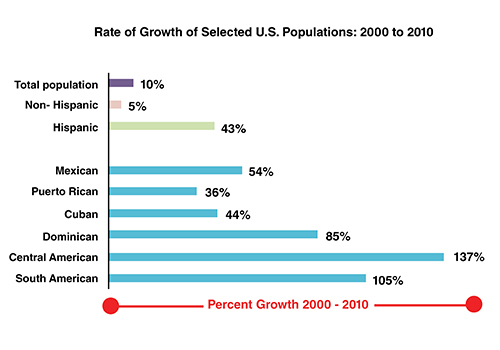
Yet, while the conventional factors influencing voluntary migration have been delineated and understood for quite some time (i.e., migrants seek better livelihoods or to reunite with family, etc.), given dynamics underlying involuntary or forced migration – such as global warming/climate change and organized gang violence – have risen to public attention and debate only recently. One particularly valuable resource tabulating trends on climate change is the International Disasters Database located at the Centre for Research on the Epidemiology of Disasters (CRED) at Belgium’s Catholic University at the Louvain. A review of Latin America’s hydrometeorological patterns over the past four decades reveals that hazardous events associated with climate change – extreme temperatures, forest fires, drought, thunderstorms, hurricanes and floods – have increased ten-fold over the period (See chart below).
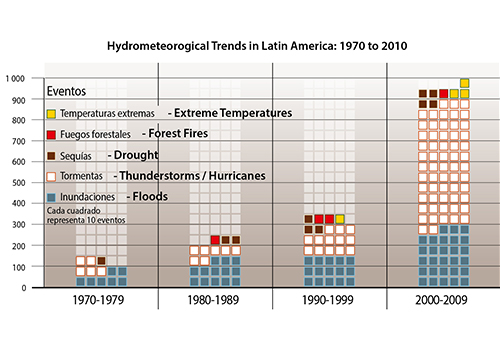
Source: “Gráficos Vitales del Cambio Climático para América Latina y El Caribe”, Programa de Naciones Unidas para el Medio Ambiente y la Comisión Económica para América Latina y el Caribe (CEPAL), 2010, p. 15 (disponible en http://www.cepal.org/dmaah/noticias/paginas/7/37867/lac_web_esp_2010-12-…)
A closer scrutiny of the most affected countries reveals that the Northern Triangle countries rise to the top globally in terms of being the countries most exposed to climate risk:
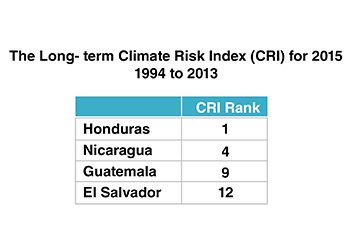
One particularly vulnerable area of climate change in the region implicates drought in the Corredor Seco Centroamericano (CSC: Central American Dry Corridor).[7] The CSC begins in the north, in Chiapas, Mexico and extends south to Guanacaste, Costa Rica and parts of western Panama [see map below]. This region is characterized by a six-month dry period in the summer and a six month wet season during winter, with a unique presence of drought during the latter.
Last year the severe lack of rainfall in the CSC posed a dangerous risk to over 2 million people, as the precipitous decline in the production of basic food staples led to critical hunger gaps. In response, the affected governments and international organizations such as the World Food Programme (WFP) and the Food and Agricultural Organization (FAO) provided emergency food and humanitarian assistance in the Corridor. Notwithstanding these mitigating actions, it is estimated that between five to twelve percent of the households in the CSC exit-migrated as part of these household’s survival strategies.[8]
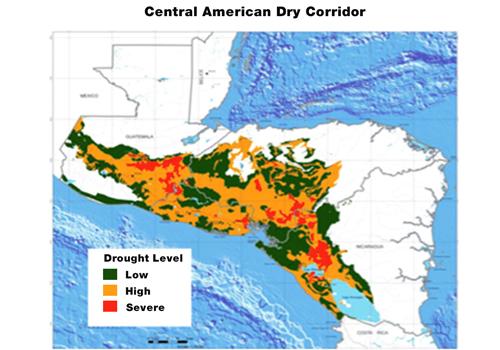
Journalistic accounts also highlighted that in some communities, such as in Guatemala, uprooted peasants chose not to migrate internally to Ciudad Guatemala (the capital) due to the ever-present threat of violent gangs. Rather, they chose to migrate to the United States.[10] A key question raised is whether this is a bell-weather of things to come. Will these emerging “eco-migrants” form part of a new flow of Central American immigrants to the United States akin to the UACs (Unaccompanied Children Migrants)?
One persistent factor destabilizing the region is the unremitting violence resulting from the trans-isthmus operations of the drug cartels and transnational gangs. Such are the levels of violence in the Northern Triangle countries that they now rank collectively as the region with the highest murder rate in the world.[11] [See bar chart below]
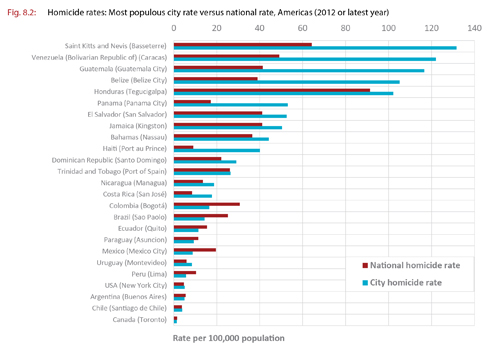
The cartels, in particular, have been instrumental in fueling the deforestation and destruction of the region’s eco-systems by illegally logging the tropical forests and establishing massive pasture lands for cattle ranch production, in order to launder money and set up logistical/air operations for continued drug-trafficking activities[12]. This rapidly evolving “narco-deforestation” is having a devastating effect on the tropical forests in Guatemala, Honduras and Nicaragua.[13] The increased presence of organized crime throughout the region is leading to the forced displacement of the population, not just in the rural area, but also in small towns and cities where they have a direct presence.[14]
The net result is that both climate-change and the different forms of organized violence have become intertwined in their effects in forcibly displacing a growing number of immigrants who do not fit the profile of earlier waves of Central American immigrants. It is still too soon to gauge what the magnitude of this immigration flow might be, but early signs point to it as a growing problem that has not yet been fully dimensionalized in the public mindset.
[1] Miguel Ugalde, “Migración y Juventud”, Abril 2013 (available http://jesuitascam.org/migracion-y-juventud/)
[2] Sierra Stoney and Jeanne Batalova, “Central American Immigrants in the United States”, The Migration Policy Institute, March 18, 2013 (available at http://www.migrationpolicy.org/article/central-american-immigrants-united-states)
[3] U.S. Census Bureau, 2011-2013 3-Year American Community Survey
[4] http://www.khou.com/story/news/2014/12/29/central-americans-predominant-group-crossing-into-us/21026277/
[5] U.S. GAO Report to Congressional Requesters, “Central America: Information on Migration of Unaccompanied Children from El Salvador, Guatemala, and Honduras”, February 2015, p.5 (available at http://www.gao.gov/assets/670/668749.pdf)
[6] D. S. Kreft, et al., “Global Climate Risk Index 2015 – Who Suffers Most From Extreme Weather Events? Weather-related Loss Events in 2013 and 1994 to 2013”, November 2014 (available at https://germanwatch.org/en/download/10333.pdf)
[7] Axel Schmidt, et al.,”Tortillas on the Roaster – Central American Maize-Beans Systems and Changing Climate Change – Full Technical Report”, October 2012 (available at http://devnewswire.crs.org.php53-27.dfw1-2.websitetestlink.com/wp-content/uploads/2012/10/Tortillas-on-the-Roaster-full-technical-report-minimum-size.pdf)
[8] Alan Brown, “Central America Drought – Situation Report #2”, World Food Program, December 12, 2014 (available at http://www.wfp.org/content/wfp-central-america-drought-situation-report-02-12-december-2014)
[9] Source: http://www.hondurasnews.com/as-central-america-drought-causes-food-shortages-un-agency-calls-for-urgent-funding/
[10] Tim Rogers, “Will climate change hasten Central American migration to US?” August 14, 2014 (available at http://fusion.net/story/6288/will-climate-change-hasten-central-american-migration-to-us/)
[11] United Nations Office on Drugs and Crime, “Global Study on Homicide 2013”, 2014 (available at http://www.unodc.org/documents/gsh/pdfs/2014_GLOBAL_HOMICIDE_BOOK_web.pdf)
[12] Count the Costs, ‘The Maya Biosphere Reserve: Guatemala’s Mini Narco-state’ in “ The War on Drugs: Causing Deforestation and Pollution”, p. 9 (available at http://www.countthecosts.org/sites/default/files/Environment-briefing.pdf)
[13] Kendra McSweeney, et al., “Drug Policy as Conservation Policy: Narco-Deforestation” Science Volume 343 31, January 2014 (available at http://raisg.socioambiental.org/system/files/Science-2014-McSweeney-489-90.pdf)
[14] La Agencia de la ONU para Refugiados, “Desplazamiento Forzado y Necesidades de Protección, generados por nuevas formas de Violencia y Criminalidad en Centroamérica, mayo de 2012 (disponible en http://www.acnur.org/t3/fileadmin/Documentos/BDL/2012/8932.pdf?view=1); David James Cantor. “The New Wave: Forced Displacement Caused by Organized Crime in Central America and Mexico”, Refugee Survey Quarterly, pp. 1–35, 2014 (available at http://rsq.oxfordjournals.org/content/early/2014/06/10/rsq.hdu008.full.pdf#page=1&view=FitH); and, Elizabeth Ferris, “Gangs, Violence and Displacement in Central America”, The Brookings Institution, November 7, 2013 (available at http://www.brookings.edu/blogs/up-front/posts/2013/11/07-central-america-armed-conflict-displacement-ferris)


![]()









